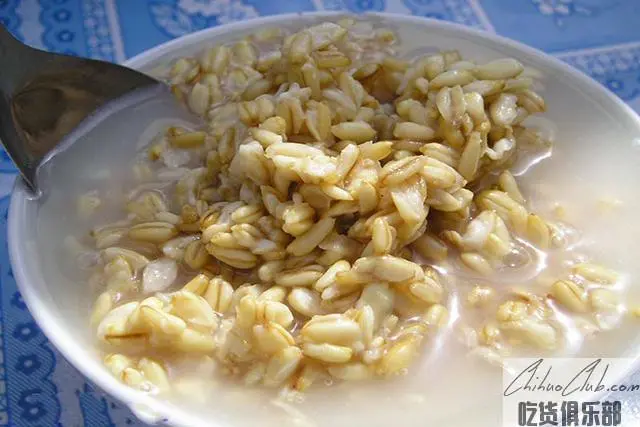
Sweet unfiltered wine
-
Update date:
-
Award date:
-
Awards:Top Ten Famous Snacks in China (Qinghai)
Sweet 醅 [pēi] is a traditional sweet food that Qinghai Han, Tibetan, Hui, Tu, Sala and other people like. Sweet and fragrant, delicious and delicious, mostly jade (ie buckwheat), barley and other raw materials. The raw materials are easy to obtain, and the brewing is convenient. It can adjust the diet and can be used for guests. It is quite popular among the masses. There is a folk saying: "Give your mouth, sweet and deserve."
Sweet quince is a sweet, sweet and mellow sweet food. After the high-quality ice-colored white wheat is crushed on the stone, it is cleaned, scoured, cooked, dried, placed in a large heat sink, and the temperature is controlled according to the season. It can be eaten after a day and two nights (about 36 hours) with the famous koji of Hubei and Shaanxi. The fermentation process is mainly composed of songs. The key is to master the temperature. The fermented seasonings are placed on the wooden bed with wheat straw, and the quilts are covered with quilts. The sweet glutinous wine produced by the fermentation is a rare thing, not only delicious, but also beautiful. And the nutritional value is extremely high. The origin of sweet glutinous rice is closely related to the brewing of alcohol in Qinghai, Tibet, Tu, and the people. It can be regarded as a homologous flow. It’s just that the koji is different. The wine cellar is also sweet and has a strong wine taste. It was used by the Tang Dynasty as a guest. Du Fu and "Guest to the Poetry" said that "the city of Panyu is far from the same. The wine is poor and only old." The old one is the wine cellar. Brewing sweet glutinous rice, the raw material is superior to jade wheat, because the jade wheat is fine and has no thick skin. Chew no slag. The second is green, but it must be peeled. The yeast is sweetly twisted and made of rice. The folks in Qinghai are called "medicine eggs" or "sweet songs". When brewing, first wash the jade or green barley with water, put it in the pot, then add the fire to the big roll, then cook slowly with the simmer until the food opens. After cooking, the food is taken to the panel, spread evenly, and it is kept cold. Grind the sweet twist into powder, evenly mix in the grain (more than half of each 13 kg of jade and spheroidal sweet koji), put it in porcelain or pottery, place it on the fire, cover the insulation (temperature below 30 °C) It is advisable to keep it clean and free of suffocation. About two days----three days, the surface of the container is hot, and the powder has a greenish white hair. There is a jingle in the crowds in Xining: "Sweet and sweet, the old man's baby mouth pharynx, a bowl of two bowls can be appetizing, three bowls and four bowls of topping rice". It can be refreshing and refreshing in summer, and it can be strong in winter. Warm the stomach and increase appetite. In the 1930s, there was a sweet shop in Xining South Street, which was once famous all over the city. The sweet glutinous rice he made is made of good white peony. In the process of sputum, sieve, sputum and leaven, he pays special attention to cleanliness. Therefore, its color is white and tender, its taste is sweet, people are competing for food, and after eating, the mouth is full of fragrance, creating The famous brand of "Han Sweet".